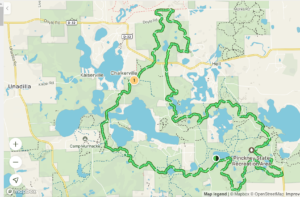
By Jennifer Fairfield
In spite of the weather the last week or so, there are definite signs of spring showing up all over – the snowdrops that come up every year in one yard I pass on my way to the store, the pussy willow I saw just the other day starting to break open in another yard, and the buds just starting to show on the silver maple and Bradford pear trees.
There’s also a lot more bird activity around my yard – the juncos seem to have just recently left, and I just spotted both a wood duck pair and a merganser pair on my pond. Speaking of my pond – the frogs have been out in full force since right around the first day of spring. They took a little break when it got so stinking cold again for a few days, but they’re back at it now. Right now, we have spring peepers, wood frogs, and chorus frogs. As the temps warm up, they’ll be joined by others – until they all get so loud you can’t hear yourself think.
That’s OK, though – I love having them sing me to sleep on spring nights. If you’re not sure who you’re hearing out there, the Cable Natural History Museum, in Wisconsin, offers information on how to identify them, both by sight and sound.
April is one of the best times to be a gardener (OK – it’s always great to be a gardener in my opinion, but some times are even better than others). The promise of a new gardening season is just so exciting, and there’s so much to do.
Garden/Yard:
Now is a good time to test your soil – before you start planting anything or adding fertilizer to established plantings. Soil conditions change over time, so it’s best to test it every year. Knowing what your soil is lacking, if anything, makes giving it what it needs to support good plant growth so much easier. Be sure to test different areas separately – don’t assume that your vegetable garden’s soil is the same as the soil in your flower beds.
And don’t forget to test the soil in your lawn. We have two very easy and reliable testing kits in stock – one that offers a digital readout of results, and one that is a little more manual, but still easy to use. Both of these kits allow you to test multiple samples. If you want a more detailed analysis of your soil’s needs, the MSU Extension Service offers a test that will give you a comprehensive look at the conditions of your soil.
Get your tools in gardening shape before you head out to use them this season. Sharp, clean tools make every job much easier. If you’re not sure how to clean and sharpen your pruners and loppers, this video will walk you through all the details.

One task most people don’t think about is sharpening shovels. A sharp shovel works better and means you don’t have to work as hard. Find tips for cleaning and sharpening shovels here. Check gloves and garden hoses for holes, and replace if necessary (April is Glove Sale Month at The Garden Mill, both in-store and online). Assess garden supports and stakes to make sure they are in good shape, and replace those that won’t make it through the season. Have your lawn mower and other power equipment serviced so that it’s ready to go when the grass starts growing. Make sure you have what you need for the season.
Speaking of mowing, now is a great time to think about how you will maintain your lawn over the season, and how you can help pollinators while doing so. MSU Extension’s article on Smart Lawns for Pollinators has some great tips for helping, or at least not harming, pollinators while keeping your lawn looking great.
April is a good time to clean up debris from the lawn, including branches brought down by the wind, and any driveway gravel that may have been plowed onto the lawn from snow plows over the winter. Getting these things done early will make lawn-mowing easier, when it’s time.
Rake up leaves that are on the lawn as well. On a dry day later in the month, rake them into a pile and then run them over with a lawn mower to chop them into small pieces. These bits of leaves make a great (free) mulch that you can add to your flower beds, trees, and shrubs. Just don’t do this until we have daytime temps consistently above 50° so that insects that might be hibernating in the leaves have a chance to come out.
Apply weed preventer to your lawn this month to keep the seeds of dandelion, crab grass, and other weeds from putting down roots when they germinate. Using corn gluten, an organic, natural weed preventer which also naturally contains nitrogen, not only helps prevent weeds, but can also help get the lawn growing. It won’t kill perennial weeds that already exist in your lawn but will keep new seeds from taking hold.
As the temperatures start to climb, and plants start to poke up out of the ground, pull mulch away from the plants to help the soil warm up more quickly. Plan to cover the plants back up, with mulch or plant protection covers if temps head below freezing at night again.
Wait to add new mulch to your planting beds, trees, and shrubs until the soil has warmed up fully – usually after Mother’s Day, or even as late as Memorial Day, depending on what Mother Nature has in store for us this year. Putting mulch down too soon can keep the soil from warming up and slow your plants’ growth and flowering.
If you didn’t cut back grasses and perennials in the fall, wait until daytime temperatures are consistently in the 50’s to do that task this spring. The reason to wait until it has warmed up is to give the beneficial insects that have spent the winter in the hollow stems and on the leaves of your plants a chance to wake up and move on. Want more tips for cleaning up in a way that isn’t harmful to beneficials?
Check out this article from Savvy Gardening.
Wait to cut back semi-woody and woody perennials until the end of the month. Tender new growth that is stimulated by pruning could be damaged by late cold snaps and frost. Before you go to work with the pruners, decide how much you want to trim based on where you see new growth, and how you want the plant to appear. What’s a semi-woody perennial? One that forms woody stems, but not as substantial as true shrubs or trees, including Russian sage, lavender, and some thymes.

Pansies, ranunculus, and primrose can generally go in flower beds and containers outside in early April, but keep plant protection covers handy – it is Michigan, after all, and we know we haven’t seen the last of the freezing temps yet. Covers help protect your plants from frost by keeping it from settling on the plant and from freeze by keeping the warmth of the soil around the plant.
Don’t be in too much of a hurry to divide perennials. Wait until after we are no longer getting frost (which is more likely in May than April, but you never know) to divide summer-blooming perennials that you didn’t get to in the fall (you can divide spring-bloomers, but they may not bloom this spring).
Plant dormant trees and shrubs once the soil can be worked. To make sure you’re giving your trees and shrubs the best chance at survival, be sure to plant them properly. The Arbor Day foundation has details for planting various types of trees, which can also be applied to shrubs.
(Publisher’s note: Part 2 of this column will publish tomorrow.)














